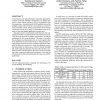Free Online Productivity Tools
i2Speak
i2Symbol
i2OCR
iTex2Img
iWeb2Print
iWeb2Shot
i2Type
iPdf2Split
iPdf2Merge
i2Bopomofo
i2Arabic
i2Style
i2Image
i2PDF
iLatex2Rtf
Sci2ools
HPCC
2007
Springer
2007
Springer
Throttling I/O Streams to Accelerate File-IO Performance
To increase the scale and performance of scientific applications, scientists commonly distribute computation over multiple processors. Often without realizing it, file I/O is parallelized with the computation. An implication of this I/O parallelization is that multiple compute tasks are likely to concurrently access the I/O nodes of an HPC system. When a large number of I/O streams concurrently access an I/O node, I/O performance tends to degrade. In turn, this impacts application execution time. This paper presents experimental results that show that controlling the number of synchronous file-I/O streams that concurrently access an I/O node can enhance performance. We call this mechanism file-I/O stream throttling. The paper (1) describes this mechanism and demonstrates how it can be applied either at the application or system software layers, and (2) presents results of experiments driven by the cosmology application benchmark MADbench, executed on a variety of computing systems...
| Added | 07 Jun 2010 |
| Updated | 07 Jun 2010 |
| Type | Conference |
| Year | 2007 |
| Where | HPCC |
| Authors | Seetharami R. Seelam, Andre Kerstens, Patricia J. Teller |
Comments (0)

